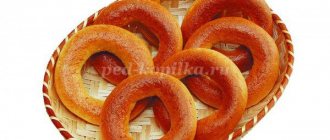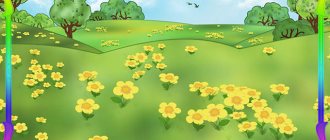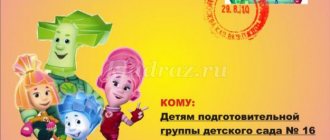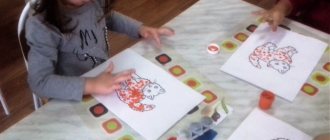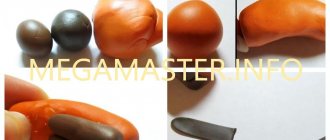Modeling lesson in the second junior group “Baranki for guests”
Victoria Vasilyeva
Modeling lesson in the second junior group “Baranki for guests”
Target:
Teach children to roll out sausages and make
bagels
.
Tasks:
Educational – to help develop the ability to roll a plasticine sausage between the palms in a circular motion; the ability to convey the form of an object, to contribute to the enrichment of vocabulary.
Developmental – promote the development of fine motor skills and attention.
Educational – to promote a caring attitude towards others.
Material:
Plasticine, boards, napkins, a picture of bagels, toys: Teddy bear, squirrel, bunny, hedgehog. tray, plates for bagels.
Preliminary work:
accumulation of vocabulary (words “Hello”, “Please”, “Thank you” and other polite words); modeling of different sausages (large and small, organization of the role-playing game “Guests”.
Educational area:
Artistic and aesthetic development.
Progress of the lesson
1. Organizational point:
Educator:
Guys, come in, look, we have guests today, let's say hello to our guests.
Children:
Hello.
Educator:
Oh guys, we have another guest today: and to get to know him, I’ll read you a nursery rhyme:
Through rubble and ravines
Teddy Bear walks with a clubfoot
He loves bee honey
Yes, he picks raspberries from the branches.
Educator:
Guys, who is this nursery rhyme about?
Children:
About the bear.
Educator:
And here is our Teddy Bear (Shows the Teddy Bear toy).
Bear:
Hello guys, today is my birthday, and to me
guests arrived.
Educator:
And what kind of guests came to Mishka? We'll find out now. (the screen opens).
Educator:
Guys, tell me who came to Mishka’s birthday?
Children:
Squirrel, bunny, hedgehog.
Educator:
Oh bear, the samovar is standing, the guests have gathered, and where is the treat for the guests?
Bear:
Guys, I don’t know what I can treat my guests to.
Educator:
Bear, don’t be upset, we will help you. Guys, please tell me what I can treat my guests to.
Children:
They offer their options.
Educator:
Guys, I suggest you help Mishka prepare delicious bagels for his guests. Tell me, what shape are the bagels?
Children:
children's answers.
Educator:
Right.
2. Main part
Educator:
Before making cookies, let's stretch our fingers.
Finger gymnastics:
We asked our stove
What should we bake (children straighten their arms forward, palms up)
We asked the stove to knead the dough (Clench and unclench fingers)
Roll out the dough with a rolling pin
Rolled out without getting tired (Move your hands back and forth with your palms down)
We are for Mishka on his birthday
Let's prepare some treats (Bake pies).
Educator:
Well done. Our fingers have warmed up, now come in and take your seats at the tables. Bear, sit with us. Look, I have a steering wheel. What shape is my steering wheel?
Lesson summary for sculpting in 2 ml gr "Sunny"
Lesson in the second junior group on modeling on the topic: “Sun”
Goals:
- To form interest and a positive attitude towards the game, the desire to participate in the general action, to help fairy-tale characters;
- Encourage children to actively communicate and develop speech;
- Consolidate knowledge about the sun (what is it for? what is it like?);
- To teach how to convey the image of the sun, improving children’s ability to roll a piece of plasticine between their palms, giving it a spherical shape; teach the technique of flattening a ball on a horizontal surface to obtain a flat image of the original shape;
- Practice rolling lumps of plasticine between your palms with direct movements of both hands;
- To encourage in children the desire to finish what they start.
Material:
- scenery of a fairy forest, mountains, sun, clouds;
- forest animals: Bunny and Squirrel (roles played by children from the preparatory group);
- record player;
- thick blue cardboard, size - A4;
- yellow and red plasticine;
- hand wipe;
- modeling board.
Preliminary work:
- Walking around the kindergarten area in order to observe the sun (during walks, the teacher teaches children to peer into phenomena, compare them, see what is common and distinctive, and with questions encourages them to find their own words and expressions to describe what they see);
- Reading the fairy tale “Visiting the Sun”;
- Examining the sun in the picture, clarifying the shape and color of the sun;
- Drawing the sun;
- Learning songs and nursery rhymes about the sun;
- Guessing riddles about natural phenomena.
Progress of the lesson
1. Organizational part.
Cheerful music sounds to the tune of the Russian folk song “Shine, shine, sun.” Children sit in a semicircle on chairs, the teacher is in front of them. Behind the teacher there is a scenery of a forest, on the right side of the teacher there is a scenery of a large mountain and clouds.
The music gradually fades away.
Educator
: Guys, listen to a very interesting riddle and tell me what it says:
It warms the whole world and does not know fatigue. He smiles at the window, And everyone calls him...
Children
: Sun.
Educator
: That's right, it's the sun. It wakes up before everyone else, washes itself from the cloud and rises high into the sky to do “good deeds.” And what “good deeds” does the sun do?
Children
: It illuminates the earth and warms everyone.
Educator
: Yes, guys, that’s right, the sun has many “good deeds”: warming the earth, illuminating it with bright light, and waking everyone up with its gentle rays. But sometimes, guys, it happens that the sun does not come out into the sky and does not give us its warmth. Why do you think?
Children
: The clouds are hiding the sun, the sun is sick...
(Several answers from the children).
At that time, Bunny and Squirrel appear from behind the forest. Sad music plays, which gradually fades away.
Bunny and Squirrel
(together)
: Hello, guys.
Children
: Hello.
Bunny
: Squirrel and I came to you for help. For several days now there has been no sun in our fairy tale, and without the sun we are cold, lonely and sad. Guys, help us find the sun.
Educator
: Well, guys, let's help our fairy tale animals find the sun?
Children
: We'll help.
Educator
: Then we need to go with you to a fairy tale. But before we go, let's remember where we can look for the sun? Where does it live?
Children
: Behind the forest there is a big mountain, on a big mountain among the clouds the sun lives,
(Several answers from children).
Educator
: Well, then let's go!
Cheerful music is playing, children and animals are walking through a fairy-tale forest.
Physical education minute
Behind the sun, behind the sun (Walking in place, raising your knees high).
Along the meadow path Let us all go joyfully in the summer time.
The ringing birds are chirping, (Walking, arms up.)
Moths are fluttering,
(Walking with arms flapping up and down).
Dandelions are turning yellow,
(Walk with your body turning to the right, right hand to the side, left hand behind your back and repeat vice versa.
) Cornflowers are turning blue.
Children with animals approach a large mountain with many clouds at the top.
Children and animals (together):
(Russian folk song)
Bucket sunshine! Look out the window! Your children are crying, jumping on the pebbles! The springs are in place.
Sunny, dress up!
Red, show yourself! Jumping in place.
Children and animals call for the sun, but it does not appear.
Educator
: Guys, the sun doesn’t appear, apparently he’s not feeling well. Let's draw him while the sun is sick. Maybe then it will disperse the clouds and begin to give everyone its warmth.
The children go to the tables, the animals remain near the mountain.
Educator
: And we will draw the sun not with pencils or paints, but with the help of plasticine. To make the sun look like a real one, let's remember what it is like. What does it look like?
Children
: On a ball, on a button, on a ball.
Educator
: What color is the sun?
Children
: Yellow, red.
Educator
: That's right, guys.
2. Practical part.
Educator
:
1. You need to take red or yellow plasticine of your choice, divide it in a stack into two parts along the intended line. Place one part between your palms. Roll the ball in a circular motion from left to right (right to left), pressing on it with your palm.
2. Place the finished ball in the middle of the cardboard and lightly press on it, flatten it so that the sun ball is fixed on the cardboard.
3. Pinch off a small piece from the second part, place it between your palms and roll the sausage with straight movements of both hands. Attach the resulting ray-column to the sun and point it to the side, lightly pressing it against the picture along the entire length of the ray. Make the remaining rays in the same way.
Warm up your arms while working
Look: the sun is above us, (Draw
a semicircle with your hand above your head (swinging motion)).
Above the trees,
(Hands raised up, fingers open).
Houses,
(Hands folded over head like a house).
And over the sea, over the wave,
(Draw a wave with your hand).
And a little bit above me.
(Touch your head).
The children finish their work, at this time the sun appears from behind the clouds. The animals jump for joy. Cheerful music is playing.
Educator
: Guys, the sun, having dispersed the clouds, floated into the sky. We managed to help the animals.
The teacher draws the children’s attention to the sun that has appeared. The children are happy. Bunny and Squirrel thank the children for their help.
3. Final part.
Educator
: Today we had a very interesting lesson. Let's remember what we did in class?
Children
: We guessed a riddle, went with Squirrel and Bunny to the sun, called the sun, sculpted a sun, (Several answers from the children).
Educator
: What did you like most?
Children
: When the sun appeared, when the sun was sculpted.
Educator
: Guys, let's enjoy the sun and play a game.
Outdoor game “Sun and Cloud”
To the music of the teacher’s words “The sun is shining,” children run, frolic, and play; on the word “cloud” - the children sit on their chairs.
Educator
: Our lesson is over, you can rest.
Summary of OOD on modeling in the second junior group “Ryabinka”
Abstract of OOD on modeling in the second junior group.
"Pock".
Target.
Teach: sculpt rowan berries from plasticine; separate small pieces from large ones in different ways (pinching, unscrewing, cutting with a knife); Roll pieces of plasticine into small balls.
Tasks.
To develop children's interest in work, teach how to form a bunch of rowan berries on a sheet of cardboard from rolled balls, and develop fine motor skills.
Material:
White cardboard with a drawn branch, plasticine, modeling board, knife, wet wipes (for wiping hands from plasticine).
OOD progress.
(Children sit on chairs opposite the teacher).
Educator.
(Includes audio recording of “Bird Voices”).
Guys, who sings this so beautifully?
Children.
Birds.
Educator.
That's right - it's the birds singing, but now it's winter outside and we can no longer hear their cheerful singing. Winter is a difficult time of year for birds, because it is cold and it is difficult to find food. Do you know what birds eat in winter?
(Children's answers).
Educator.
Well done! We also have a special tree on our site, the berries of which ripen in late autumn and hang on the tree almost all winter. Birds love to peck these berries.
(The teacher shows the children a rowan branch).
(Children's answers).
Educator.
That's right - these are rowan berries, look how bright they are, berry by berry, there are a lot of berries, they are collected in a bunch.
Guys, what color are rowan berries?
Children.
Red, orange.
Educator.
What shape are they?
Children.
Round.
Educator.
What size are they?
Children.
Small ones.
Educator.
Well done, guys! And who will tell me or show me how birds peck rowan berries?
(Children's displays and answers).
If you want, you and I will turn into birds, but for this you need to say magic words.
One, two, three, spin around,
Be sure to turn into a bird.
So you and I have become birds, stand in a circle and repeat after me.
Fizkul (author Logvina A.N.)
Birds jumped in the snow (Children jump into a circle from a circle)
They were looking for grains and berries. (Waving their arms and turning their heads)
Here is luck, a bunch of rowan berries, (They wave their arms and spin around in place)
We will be full today. (Children bend their heads forward,
imitating birds pecking on berries)
We refreshed ourselves, rested,
Now it's time for us to hit the road! (Waving their arms and running in a circle)
Educator.
Guys, it’s time for us to turn back into children, let’s say the magic words together.
One, two, three, spin around,
Turn into a child again.
I suggest you make a bunch of rowan berries for our wintering birds. Take a seat at the tables. Look (I show and comment) to make rowan berries we will need red plasticine. We pinch off (unscrew or cut off with a knife) a small piece from a large piece of plasticine, place it on the palm of my left hand, cover it with my right palm and roll out the plasticine in a circular motion. Now the berry is ready, I apply it to the branch and lightly press it with my index finger. But look (demonstration of a rowan branch) there are a lot of berries on the branch and they are located next to each other. Let's make a lot of berries so that we can get big, beautiful bunches of rowan berries. And we will give these bunches to the birds sitting at our creative stand.
(The children begin to work, the teacher prompts, guides, and helps the children as necessary).
Educator.
I see you have already finished making a bunch of rowan berries. (The teacher organizes an exhibition of children's works). Look what beautiful bunches of rowan berries you got. I am very glad that we were able to help wintering birds.

